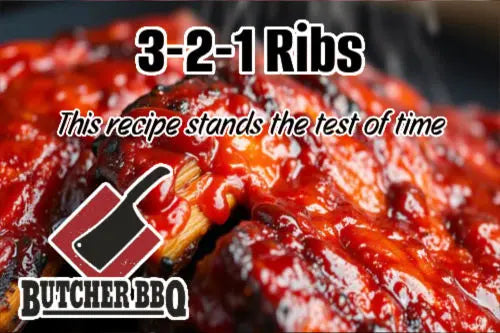
Mastering the 3-2-1 Rib Cooking Method: Tender, Juicy Ribs Every Time
2 comments
3-2-1 Rib Method Never Fails
If you're a BBQ enthusiast, you've probably heard of the 3-2-1 rib cooking method. This tried-and-true technique is a favorite among competition pitmasters and backyard grillers alike, and for good reason. It consistently produces tender, juicy ribs with a delectable smoky flavor that will have your guests begging for more.
In this blog post, we'll dive deep into the 3-2-1 method, sharing tips and tricks to help you master this foolproof approach to rib perfection. Whether you're a seasoned BBQ veteran or a newbie looking to up your rib game, this guide has got you covered.
Selecting the Right Ribs
The foundation of any great rib dish starts with the quality of the meat. When it comes to the 3-2-1 method, you'll want to opt for either baby back ribs or St. Louis-style spare ribs. These cuts are well-suited to the long, slow cooking process, ensuring the connective tissues break down and the meat becomes meltingly tender.
When selecting your ribs, look for a nice, even thickness throughout the rack. Avoid any that are overly thin or have large gaps between the bones, as these can dry out during the cooking process. Additionally, inspect the membrane on the back of the ribs – you'll want to remove this before seasoning to allow the rub and smoke to penetrate the meat more effectively.
Preparing the Ribs
Once you've chosen your ribs, it's time to get them ready for the smoker. Start by trimming off any excess fat or silver skin on the back of the rack. This will help the rub and smoke better penetrate the meat.
Next, it's time to apply your seasoning. A good rib rub is the foundation of the 3-2-1 method, so take the time to find a blend that suits your taste buds. Whether you prefer a sweet and savory mix like our Honey Rub Blends or something with a little heat like our Sweet Chipotle Rub, the key is to generously coat the ribs on all sides, ensuring even coverage.
The 3-2-1 Method Explained
Now, let's dive into the heart of the 3-2-1 technique:
The First 3 Hours: Smoking
The first step in the 3-2-1 method is to smoke the ribs for 3 hours at a consistent temperature of 225-250°F. This low and slow approach allows the smoke to infuse the meat with a delectable flavor while gradually breaking down the connective tissues.
During this initial smoking phase, you'll want to use a combination of direct and indirect heat. Start by placing the ribs directly over the heat source, then after about an hour, move them to the cooler side of the grill or smoker to finish cooking with indirect heat. This helps to ensure even cooking and prevents the outside from drying out while the interior continues to tenderize.
The Next 2 Hours: Wrapping
After the first 3 hours of smoking, it's time to wrap the ribs in foil or butcher paper. This "Texas crutch" step helps to steam the ribs, further breaking down the tough connective tissues and infusing the meat with moisture. During this 2-hour phase, you can also add a splash of apple juice, beer, or your favorite BBQ sauce to the foil or paper wrap to keep the ribs moist and flavorful. We have another blog article on this very method, click here to read about what to wrap ribs with.
The Final 1 Hour: Glazing and Finishing
In the final hour of the 3-2-1 method, it's time to unwrap the ribs and apply a glaze or sauce. This last step helps to caramelize the exterior, creating a beautiful, sticky finish that complements the tender, juicy interior.
You can use your favorite Butcher BBQ sauce or experiment with a homemade glaze. Just be sure to apply it in the last 30 minutes of cooking to prevent the sugars from burning. Once the ribs have reached your desired level of doneness, remove them from the heat, let them rest for a few minutes, and then slice and serve.
Tips and Tricks
To help you get the most out of the 3-2-1 method, here are a few additional tips and tricks:
- Spritz the ribs with a mixture of apple juice, apple cider vinegar, or water every 30-45 minutes during the initial smoking phase. This helps to keep the meat moist and prevent it from drying out.
- Adjust the cooking times based on the size and thickness of your ribs. Thicker racks may require an extra hour or two of smoking, while smaller baby backs may need less time in the foil.
- Let the ribs rest for 10-15 minutes before slicing and serving. This allows the juices to redistribute throughout the meat, ensuring maximum tenderness and flavor in every bite.
Conclusion
The 3-2-1 rib cooking method is a game-changer for anyone looking to up their BBQ game. By following this simple, yet effective technique, you can consistently produce tender, juicy ribs with a delectable smoky flavor that will have your friends and family raving.
So, what are you waiting for? Fire up your smoker or grill, grab some high-quality ribs, and get ready to master the 3-2-1 method. Your taste buds (and your guests) will thank you.





Comments (2)
Richard: We have several really good recipes for briskets right here on our blog. Use the navigation bar and go down to beef, then it will show briskets, that is where all brisket cooking blogs are located. If you have any further questions please ask.
What is a good brisket recipe, time and temperature for a medium size brisket?